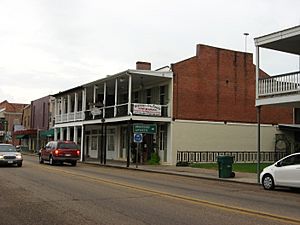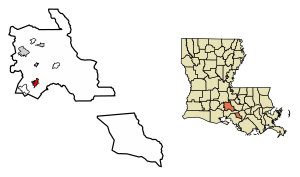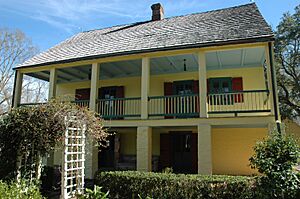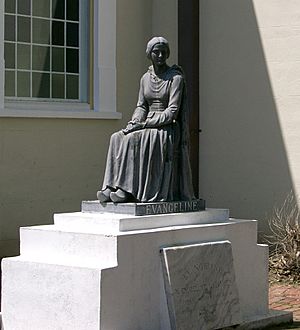St. Martinville, Louisiana facts for kids
Quick facts for kids
Saint Martinville
Saint-Martin (French)
|
|
|---|---|
| City of Saint Martinville Ville de Saint-Martin (French) |
|

Main Street
|
|
| Nickname(s):
Petit Paris (Little Paris)
|
|

Location within St. Martin Parish, Louisiana
|
|
| Country | |
| State | |
| Parish | St. Martin |
| Area | |
| • Total | 3.16 sq mi (8.18 km2) |
| • Land | 3.05 sq mi (7.90 km2) |
| • Water | 0.11 sq mi (0.28 km2) |
| Elevation | 23 ft (7 m) |
| Population
(2020)
|
|
| • Total | 5,379 |
| • Density | 1,762.45/sq mi (680.56/km2) |
| Time zone | UTC-6 (CST) |
| • Summer (DST) | UTC-5 (CDT) |
| ZIP Code |
70582
|
| Area code(s) | 337 |
| FIPS code | 22-67600 |
St. Martinville (called Saint-Martin in French) is a city in Louisiana, United States. It is the main town, or parish seat, of St. Martin Parish. The city is located on Bayou Teche, a slow-moving river. It is about 13 miles (21 km) south of Breaux Bridge. St. Martinville is also 16 miles (26 km) southeast of Lafayette. In 2020, about 5,379 people lived there. The city is part of the larger Lafayette metropolitan area.
Contents
History of St. Martinville

In the 1500s, the land where St. Martinville is now was home to many groups of Attakapan people. Traders from other areas often visited this territory.
Europeans began to settle here after France claimed the colony of Louisiana in 1699. The French called the area "Attakapas Territory." This name came from the Choctaw language. The French government gave land to its soldiers and settlers.
Early Settlements and French Arrivals
A trading post called Poste des Atakapas was set up on the Bayou Teche. More settlers started to arrive. Some came from France, like M. Masse in 1754. Gabriel Fuselier de la Claire and other Frenchmen from Mobile arrived in 1763 or 1764. Fuselier bought land from the Attakapas chief Kinemo. Later, another group called the Appalousa (now known as Opelousas) came and many of the Eastern Attakapan people were lost.
More French-speaking people arrived, including the first Acadians in 1765. They came from Nova Scotia (a part of Canada today). The British had forced them out of Acadia after winning the Seven Years' War. Spain then took over Louisiana, but French colonists still helped to manage it.
Joseph Broussard led the Acadians. Later, in 1768-1769, fifteen families arrived from Pointe Coupee. These families had moved from places like Haïti or Paris. In 1764, a French captain named Étienne de Vaugine also bought a large area of land east of Bayou Teche.
By April 1766, after the Acadians arrived, the Attakapas region had 409 people. In 1767, the Attakapas Post had 150 people before the new families came from Pointe Coupee.
Louisiana Purchase and New Leadership
In 1803, Napoleon sold Louisiana to the United States. This event is known as the Louisiana Purchase. After Louisiana became a state, Saint Martin Parish was created. Attakapas Post was then renamed Saint Martinville and became the main town of the parish.
In 1867, Governor Benjamin Flanders chose Monroe Baker to be the mayor. Monroe Baker was one of the first African-American mayors in the United States.
Geography of St. Martinville
St. Martinville is located at 30°7′30″N 91°49′50″W / 30.12500°N 91.83056°W. It is in a region called Acadiana, which is known for its Cajun culture. The city is part of the Lafayette metropolitan area. This means it's part of a larger group of towns and cities around Lafayette.
The city covers about 3.0 square miles (7.8 square kilometers) of land. A very small part of it is water. The land around St. Martinville is a mix of swampy areas and open grasslands.
Population Changes
| Historical population | |||
|---|---|---|---|
| Census | Pop. | %± | |
| 1850 | 652 | — | |
| 1870 | 1,190 | — | |
| 1880 | 1,606 | 35.0% | |
| 1890 | 1,814 | 13.0% | |
| 1900 | 1,926 | 6.2% | |
| 1910 | 2,318 | 20.4% | |
| 1920 | 2,465 | 6.3% | |
| 1930 | 2,455 | −0.4% | |
| 1940 | 3,501 | 42.6% | |
| 1950 | 4,614 | 31.8% | |
| 1960 | 6,468 | 40.2% | |
| 1970 | 7,153 | 10.6% | |
| 1980 | 7,965 | 11.4% | |
| 1990 | 7,137 | −10.4% | |
| 2000 | 6,989 | −2.1% | |
| 2010 | 6,114 | −12.5% | |
| 2020 | 5,379 | −12.0% | |
| U.S. Decennial Census | |||
The population of St. Martinville has changed over the years. In 2020, there were 5,379 people living in the city. In 2010, the population was 6,114.
Diversity in St. Martinville
St. Martinville is a diverse city. In 2020, about 60.23% of the people were Black or African American. About 34.45% were White. Other groups included Native American, Asian, and people of two or more races. About 2.01% of the population was Hispanic or Latino.
Many people in St. Martinville speak English. In 2005, about 15.9% of people spoke French at home. About 2.7% spoke Louisiana Creole French.
Economy and Jobs
The economy of St. Martinville relies on farming and tourism. Farmers in the area grow crawfish and sugar cane. Sugar cane has been an important crop for a long time.
Education in St. Martinville
Public schools in St. Martin Parish are managed by the St. Martin Parish School Board. Students in St. Martinville attend:
- Early Learning Center (for Pre-Kindergarten and 1st grade)
- St. Martinville Primary School (for grades 1-5)
- St. Martinville Junior High School (for grades 6-8)
- St. Martinville Senior High School (for grades 9-12)
The city also has a campus of Louisiana Technical College. This college helps students learn skills for different jobs.
Culture and Arts

St. Martinville is very important to Cajun culture. It is in the middle of a region called Cajun Country. The city has a rich mix of cultures. This includes Acadians (Cajuns), Creoles, French, Spanish, and African people.
St. Martinville was once known as Petit Paris (Little Paris). This nickname came from a time when the city was a cultural center. It had nice hotels and a French theater called the Duchamp Opera House. This theater, founded in 1830, showed operas and funny plays.
St. Martinville is one of the oldest towns in Louisiana. It has many historic buildings and homes. The old St. Martin of Tours Catholic Church and La Maison Duchamp are part of the Acadian heritage. The church is named after a church in France.
The city is also home to the "Evangeline Oak." This tree is famous from Henry Wadsworth Longfellow's poem about the Acadians being forced from their homes.
St. Martinville has an African American Museum. It is also a stop on the Louisiana African American Heritage Trail. This trail was created in 2008 to highlight important African American history sites.
The 2013 movie Christmas on the Bayou was filmed in St. Martinville. It stars Hilarie Burton as Katherine, a busy mom. She comes to St. Martinville for Christmas and finds romance.
Famous People from St. Martinville
- Calvin Borel: A jockey who won the Kentucky Derby three times.
- Jefferson J. DeBlanc: A brave pilot in World War II who received the Medal of Honor.
- Early Doucet: A wide receiver who played football for LSU and the Arizona Cardinals.
- Willie Francis: A person who survived an electric chair execution attempt when he was 17.
- Paul Jude Hardy: The first Republican to be elected Lieutenant Governor of Louisiana.
- Jay Hebert: A professional golfer who won the 1960 PGA Championship.
- Jeff Landry: A former congressman and the current Governor of Louisiana.
- Darrel Mitchell: A professional basketball player.
- Fred H. Mills, Jr.: A Republican state representative for St. Martin Parish.
- Nathan Williams: A famous zydeco accordion player and singer.
Sister Cities
St. Martinville has special connections with cities in other countries. These are called "sister cities":
- Ploermel, Brittany, France
- Bouctouche, New Brunswick, Canada
- Chaudfontaine, Wallonia, Belgium
- Goree Island, Senegal, West Africa
Images for kids
See also
 In Spanish: St. Martinville para niños
In Spanish: St. Martinville para niños




